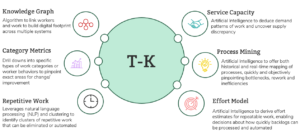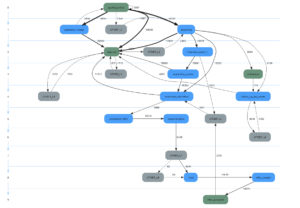Recruiting Pipeline T-K Use Case

3 min read
This post is a part of the T-K Use Cases series, highlighting means by which T-K can be used in various industry settings.
Key Challenges in Recruiting
It’s no secret that acquiring the right talent is one of the most important keys to growth for a company. While making good hires often feels closer to an art than a science, many employers are trying to flip this notion. 15% of executives surveyed in a Harvard Business Review study are proactively employing workforce data to monitor their operations. The proliferation of virtual backdrops during the pandemic, which further complicated the hiring process for both recruiters and candidates, has emphasized the importance of leveraging this data. If you’re constantly looking to improve your recruitment pipeline, here are some of the top key challenges that may be facing your hiring team in 2022.
Protracted recruitment pipelines: how can we streamline and minimize wasted work to maintain an efficient and effective pipeline for all parties involved? Protracted job cycles not only burden your recruiters but can also prompt candidates to reject offers or withdraw their applications entirely.
Inconsistent hiring practices: are we ensuring that each candidate’s application is afforded due process? In addition to improving the quality of your candidate selections, consistency in the recruiting pipeline fosters a positive experience for candidates themselves and can lead to improved diversity and inclusion.
Complex staffing needs: how do we monitor areas of over- and under-staffing so our recruiting pipeline can adapt to demand? Lowering the latency between recognizing and filling a staffing need requires real-time monitoring capabilities that are often difficult to scale for large operations.
Rudimentary reporting capabilities: how do we track and re-prioritize these opportunities over time? Current practices may be manual, time-consuming, and bereft of benchmark performance metrics to evaluate success and candidate satisfaction.
T-K Solution – an Intelligence Engine
T-K by CKM Analytix leverages your existing applicant tracking systems (e.g., Greenhouse, ClearCompany, etc.) to provide actionable insights on a real-time basis that reduce operational costs, accelerate the recruitment cycle, and promote a positive experience for both recruiters and candidates.
Figure 1. T-K’s Modules

![]() Parsing these disparate sources of data allows us to construct an Effort Model – a set of proprietary CKM algorithms – to measure recruiting activity on an individual basis. By normalizing human effort across different types of work, the model provides a comparable, quantifiable, and fair estimate of true effort.
Parsing these disparate sources of data allows us to construct an Effort Model – a set of proprietary CKM algorithms – to measure recruiting activity on an individual basis. By normalizing human effort across different types of work, the model provides a comparable, quantifiable, and fair estimate of true effort.
![]() Service Capacity highlights areas of over- and under-staffing, measuring talent supply and staffing demands. The Effort Model allows recruiters to quantify FTE needs relative to demand so that they can be compared across teams (e.g., internal vs. external recruiters). This, in turn, serves as an indicator of where improvements, such as self-service capabilities, can help reduce the burden on HR personnel.
Service Capacity highlights areas of over- and under-staffing, measuring talent supply and staffing demands. The Effort Model allows recruiters to quantify FTE needs relative to demand so that they can be compared across teams (e.g., internal vs. external recruiters). This, in turn, serves as an indicator of where improvements, such as self-service capabilities, can help reduce the burden on HR personnel.
![]() Process Mining reveals bottlenecks in the recruitment funnel along several different dimensions, and allows power users to identify which stages of recruitment are major drivers of withdrawn applications and should be targeted for a reduction in time to hire. By bringing in the Effort Model, you can quantify the potential opportunities related to unproductive rework and process conformance. The latter is crucial for understanding how consistently you conduct recruitment for a particular job.
Process Mining reveals bottlenecks in the recruitment funnel along several different dimensions, and allows power users to identify which stages of recruitment are major drivers of withdrawn applications and should be targeted for a reduction in time to hire. By bringing in the Effort Model, you can quantify the potential opportunities related to unproductive rework and process conformance. The latter is crucial for understanding how consistently you conduct recruitment for a particular job.
Figure 2. The Process Mining Module
Visualizes stages of the recruitment cycle to identify bottlenecks and inefficiencies

![]() Category Metrics evaluates the performance benchmarks (e.g., time-to-hire) of your recruitment pipelines to identify training opportunities across the organization. It can also be harnessed in real-time to identify expertise in employees, (e.g., being an effective screener of applicants) for a more efficient and targeted recruiting process.
Category Metrics evaluates the performance benchmarks (e.g., time-to-hire) of your recruitment pipelines to identify training opportunities across the organization. It can also be harnessed in real-time to identify expertise in employees, (e.g., being an effective screener of applicants) for a more efficient and targeted recruiting process.
Conclusion – Tracking Progress in T-K Real Time
By linking the narratives of these modules and leveraging them in real-time, T-K allows users to diagnose problems and streamline the recruitment pipeline dynamically in response to automated alerts that function as prompts when opportunities arise. Perhaps most importantly, these insights are never a snapshot in time and emphasize the importance of tracking progress as an ever-evolving trend.
You may be interested in other T-K use cases as part of the series:
